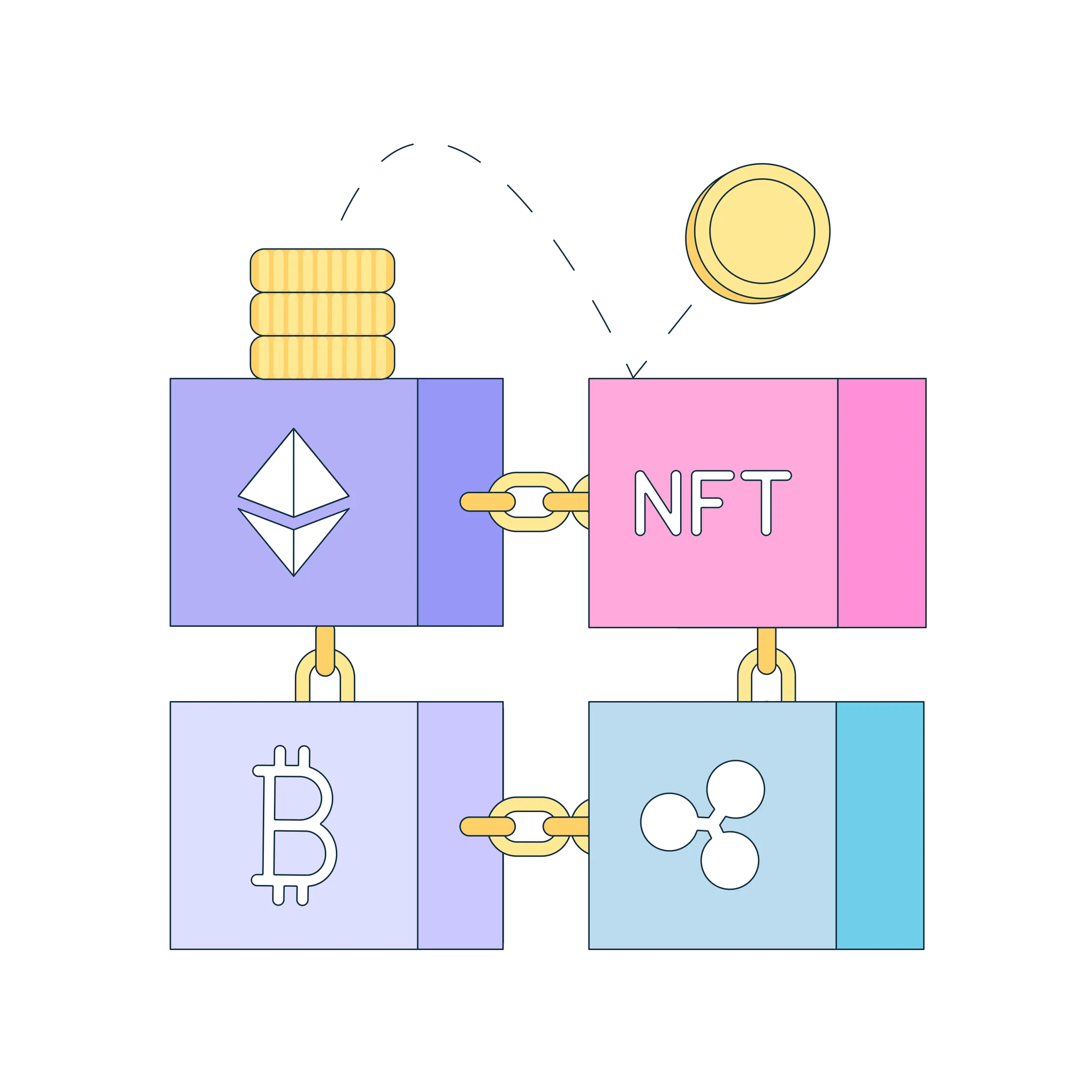Public key and private key are at the heart of the safety of assets , guaranteeing their protection against theft or loss. Unfortunately, poor management of these keys can have disastrous consequences, such as hacking funds or the impossibility of accessing your portfolio.
The protection of your cryptos is also based on the choice of the good type of wallet: the hot wallet S , connected to the Internet, offer decentralization and ease of access, but remain more vulnerable to cyber attacks; While the cold wallet S , disconnected and therefore much more secure, represent the ideal solution for long -term storage.
So how do these keys work and why is their management crucial in the world of cryptocurrencies? Let us explore together these essential concepts to protect your assets in a decentralized system.
Table of contents
Public key and private key, what exactly is it?
A simple definition
Imagine your public key as a RIB (bank identity statement): you can share it without risk to receive funds. On the other hand, your private key is like the password of your bank account : it must remain strictly confidential, because it gives total access to your cryptocurrencies.
- Public key : it is used to receive cryptos. You can safely send it to anyone who wishes to send you funds, just as you would give a RIB.
- Private key : it allows you to unlock and spend your cryptos. If someone seizes it, it can access your wallet and steal your digital assets.
How do they work together?
These two keys are based on a fundamental concept called asymmetrical cryptography . This principle is based on a couple of mathematically linked keys: a public key and a private key.
Here's how it works:
- The public key is used to "lock" funds in your wallet. When someone sends you cryptos, the transaction is recorded on the blockchain and associated with your public key. In other words, the public key designates a place where cryptos are deposited, but does not allow you to access it directly.
- The private key , on the other hand, is essential to "unlock" these funds. It is she who digitally signs each transaction to prove that you are indeed the legitimate owner of these cryptos. Without this signature, the funds remain inaccessible.
This mechanism provides robust security because only the private key holder can access cryptocurrencies. However, if this private key is compromised or lost, your funds become irrecoverable. This highlights the importance of protecting it with care, just as you would protect the password from your bank account.

Why are the keys unique?
When a user creates a portfolio for the first time, whether via a hot wallet (connected to the Internet, such as Metamask, Trust Wallet or Exodus) or a cold wallet (like Ledger or Tangem, disconnected from the Internet), a cryptographic system automatically generates a private key and one or more associated public keys
More information here
A public key by blockchain
The private key is the basis of everything. It is used to derive one or more public keys. However, each blockchain has its own characteristics and uses different methods to generate public addresses. So :
- A single private key allows you to control several public addresses on different blockchains.
- For example, a public key used on Ethereum will be different from that used on Bitcoin, even if they are all derived from the same private key. This facilitates interoperability while ensuring that the funds on each blockchain are correctly isolated.
The role of the Seed Phrase
When creating a portfolio, a seed sentence (recovery sentence) is also provided to the user. This sentence, composed of 12, 18 or 24 words, is actually a simplified and human version of the private key.
This means that seed phrase is the ultimate backup of your wallet. But beware: if someone gets your seed phrase, they can access all your cryptos , whatever the blockchain.
Good practices to secure your keys
Use a secure wallet
To protect your keys, it is essential to choose a portfolio adapted to your needs:
- Warm portfolios ( hot wallet s) : these tools, connected to the Internet, such as Metamask, Trust Wallet or Exodus, are practical to access its funds quickly and carry out transactions above. But they are more vulnerable to online attacks, such as phishing or hacks.
- Cold wallets ( cold wallet S) : These devices, like Ledger or Tangem, work offline. They offer maximum security because they are isolated from networks, thus considerably reducing the risk of hacking.
Save your keys
-
- If possible, use several copies of your Seed Phrase. Store them in different places, for example in a safe or a secure place in a loved one.
Never share your seed phrase or private key with anyone. Scams often target users by asking for this information under the pretext of technical aid or investment opportunities .
Note your seed phrase on paper, in a safe place, and never store it online. A photo or digital copy could be compromised in case of hacking your device or cloud account.
Update your safety practices regularly
- Check the origin of your wallets: Download the wallet apps only from the official sites or blinds to avoid compromise versions.
- Activate additional protections: if your hot wallet allows, add a safety layer, such as a password or biometric authentication.
- Stay informed of threats: attacks, such as malware or phishing scams, evolve. Knowing the risks can help you protect yourself better.
Public key and private key in the crypto ecosystem
Their role in centralized and decentralized exchanges
On a CEX (centralized exchange) like Binance , Coinbase or Crypto.com, the platform holds your private keys and do not share them. This means that you do not have direct control over your cryptocurrencies, unlike a personal wallet. However, to receive funds, each CEX provides unique public keys for each supported blockchain network ( Ethereum , Bitcoin , Solana , etc.).
These public keys are associated with your centralized account. For example, if you send funds to an Ethereum public key supplied by Binance , these funds will be credited directly to your Binance . The public key thus acts as an identifier to receive funds on the platform, but the private key remains entirely under the control of the centralized exchange.
In a Dex (decentralized exchange), the situation is different. You connect the DEX to your wallet. Thus, you hold your private keys and your public key, which gives you total autonomy on your assets. It also means that you are entirely responsible for their security, which requires rigorous management of sensitive information such as your Seed Phrase and your private key.
Cases of use of keys in the web3
Access to decentralized applications (DAppS)
In the world of web3 , your private and public keys are the front door to interact with a multitude of decentralized applications ( DApp S ). It is thanks to your digital wallet, which contains your keys, that you can access and use these services.
For example, your keys allow you:
- to exchange cryptocurrencies on Dex (decentralized exchanges) such as Uniswap or Sushiiswap ,
- to do perpetual contracts on platforms like Hyperliquid , dYdX or Drift
- to buy NFTS on OpenSea ,
- to obtain a decentralized loan via protocols like AAVE or Compound ,
- Or stike your cryptocurrencies on platforms like Lido to generate yields.
Each transaction or interaction with these DAppis signed digitally with your private key, thus guaranteeing your authorization and the security of the operation.
Concrete example: perpetual contracts
To trade perpetual contracts , your keys play a crucial role. They make it possible to interact directly with the smart contract of the platforms such as Hyperliquid or dYdX . These intelligent contracts automatically perform transactions and guarantee the transparency of exchanges. Thanks to your keys, you can open, manage and close your positions independently, without depending on an intermediary.
FAQ on private and public keys
1. Why are private keys so important?
Private keys allow access and spend your cryptocurrencies. If you lose them, your funds become inaccessible. They are the majority of time materialized by a seed sentence.
2. Where should I store my private keys?
Use a secure wallet, preferably a cold wallet, and note your key on paper in a safe place.
3. Can I share my public key without risk?
Yes, the public key is only used to receive cryptos. It gives no access to your funds.
4. What to do in the event of loss of my private key?
Unfortunately, there is no way to recover a lost private key. The backup is therefore essential.
Conclusion
Public and private keys are the cornerstone of security in the universe of cryptocurrencies. Understanding how it works and adopting good practices is crucial to sail serenely in this ecosystem. To deepen your knowledge, click on the words in bold to discover our articles on CEX VS Dex and the web3 , two essential concepts to master the crypto universe.
Investments in cryptocurrencies are risky. Crypternon could not be held responsible, directly or indirectly, for any damage or loss caused following the use of a property or service put forward in this article. Investments linked to cryptocurrencies are risky by nature, readers must do their own research before undertaking any action and investing only within the limits of their financial capacities. This article does not constitute an investment .
Certain links of this article are affiliated, which means that if you buy a product or register via these links, we will collect a commission from our partner. These commissions do not train any additional cost for you as a user and some even allow promotions.
AMF recommendations. There is no guaranteed high yield, a product with high performance potential implies a high risk. This risk taking must be in line with your project, your investment horizon and your ability to lose part of this savings. Do not invest if you are not ready to lose all or part of your capital .
To go further, read our pages legal notices , privacy policy and general conditions of use .


